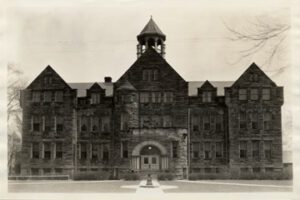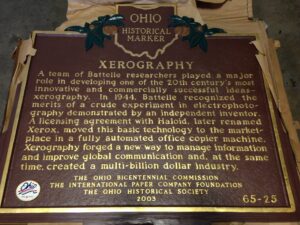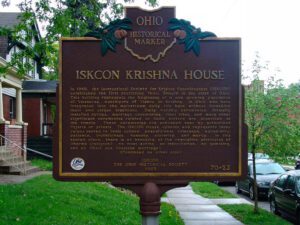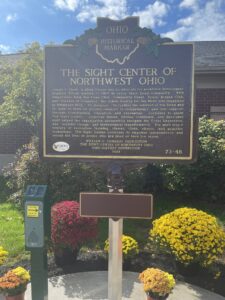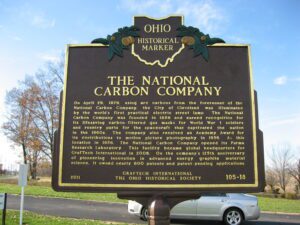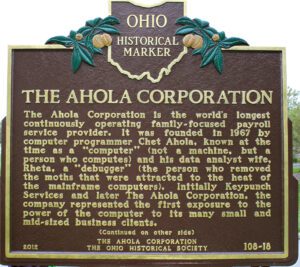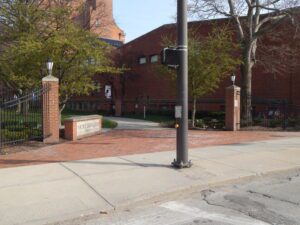, OH
In 1845, Baldwin Institute, one of the first schools in the area open to all students regardless of gender, race, or creed, was chartered. The wealth generated by the sandstone and grindstone industries of Berea allowed John Baldwin to found the school. Ten years later, officials rechartered the school and renamed it Baldwin University. By the 1880s, the expanding quarries began to encroach on the original campus of the university, forcing it to relocate. In 1891, ground was broken for the new campus at the corner of Front Street and Bagley Road. Recitation Hall, renamed Wheeler Hall, was the first new building, followed by the Philura Gould Baldwin Memorial Library in 1894. In 1905, through the funding of the Carnegie Foundation, the Ladies Hall, renamed Carnegie Hall, was moved stone by stone to the new campus to serve as the science building. Baldwin University merged with German-Wallace College in 1913 to become Baldwin-Wallace College.
, OH
A team of Battelle researchers played a major role in developing one of the 20th century’s most innovative and commercially successful ideas–xerography. In 1944, Battelle recognized the merits of a crude experiment in electrophotography demonstrated by an independent inventor. A licensing agreement with Haloid, later renamed Xerox, moved this basic technology to the marketplace in a fully automated office copier machine. Xerography forged a new way to manage information and improve global communication and, at the same time created a multi-billion dollar industry.
, OH
In 1968, the International Society for Krishna Consciousness (ISKCON) established the first practicing Vedic Temple in the state of Ohio. This building represents the beginning of a now growing population of Vaisnavas, worshipers of Vishnu or Krishna, in Ohio who have integrated into the mainstream daily life here without forsaking their own unique traditions. Daily worship ceremonies, formally installed deities, marriage ceremonies, final rites, and many other significant ceremonies related to Vedic culture are practiced at the temple. These ceremonies are prevailed over by authorized Pujaris or priests. The ISKCON House upholds and represents those values sacred to Vedic culture: peacefulness, tolerance, equanimity, patience, truthfulness, honesty, austerity, and mercy. In this sacred place, there is no breaking of the regulative principles of Dharma (religion): no meat eating, no intoxication, no gambling, and no illicit sex (outside marriage).
, OH
Joseph F. Clunk, a blind Ohioan and an advocate for workforce development, inspired Toledo leaders in 1923 to serve their blind community. With cooperation from the Lions Club, Community Chest, Toledo Rotary Club, and Chamber of Commerce, the Toledo Society for the Blind was organized in November 1923. Its purpose, “to further the interest of the blind and to open to them all possible avenues to independence and self-support, through investigation, education, and recreation,” continues to guide The Sight Center. Generous donors, tireless volunteers, and dedicated staff helped the organization successfully navigate the Great Depression, war, societal change, and technological transformation. For more than a century of innovative training, classes, clubs, clinics, and assistive technology, The Sight Center continues to empower independence and enrich the lives of people who are blind or have low vision.
, OH
On April 29, 1879, using arc carbons from the forerunner of the National Carbon Company, the City of Cleveland was illuminated by the world’s first practical electric street lamp. The National Carbon Company was founded in 1886 and earned recognition for its lifesaving carbon-filtered gas masks for World War I soldiers and reentry parts for the spacecraft that captivated the nation in the 1960s. The company also received an Academy Award for its contributions to motion picture photography in 1956. At this location in 1956, The National Carbon Company opened its Parma Research Laboratory. This facility became global headquarters for GrafTech International in 2006. On the company’s 125th anniversary of pioneering innovation in advanced energy graphite material science, it owned nearly 800 patents and patent-pending applications.
, OH
The Ahola Corporation is the world’s longest continuously operating family-focused payroll service provider. It was founded in 1967 by computer programmer Chet Ahola, known at the time as a “computer” (not a machine, but a person who computes) and his data analyst wife, Rheta, a “debugger” (the person who removed the moths that were attracted to the heat of the mainframe computers). Initially Keypunch Services and later the Ahola Corporation, the company represented the first exposure to the power of the computer to its many small and mid-sized business clients.
, OH
In 1886, Bishop Richard Gilmour (1824-1891) of the Roman Catholic diocese of Cleveland requested that the Jesuit superior of Buffalo establish a high school on Cleveland’s west side. The Jesuits, an order of the Roman Catholic Church founded by St. Ignatius Loyola in 1540, sought to establish schools that instilled a zeal for the Gospel and a love of learning. Under the leadership of Father Henry Behren, S.J. (1815-1895), the twentieth Jesuit secondary school in the United States opened in September 1886. Named Saint Ignatius College, the school grew from 76 students in 1886 to 490 in 1924. In 1924, the College split into two separate institutions: John Carroll University, which moved to University Heights in 1935, and Saint Ignatius High School, which remains on its original site. (Continued on other side)


